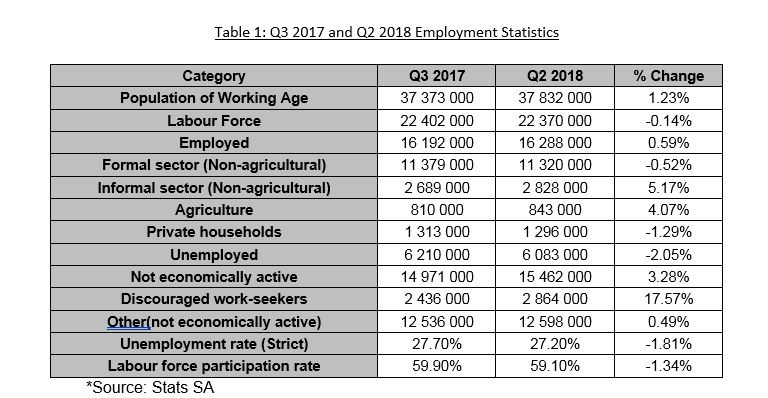Unemployment has historically been a challenge for South Africa and has remained at persistently high levels over the past two decades.
The South African economy has seen a 0.7% decrease in the second quarter of 2018 in gross domestic product (GDP).
This followed a revised 2.6% contraction in the first quarter of 2018.
This places the South African economy in a technical recession which has been a contributor to the rand’s recent steep depreciation.
The most negatively affected industries in the second quarter were the agriculture, forestry and fishing industry which declined by 29.2%, followed by the transport, storage and communication industry declining 4.9% and finally the trade, catering and accommodation industry which declined 1.9%.
President Cyril Ramaphosa has stated that job creation (with an emphasis on youth employment opportunities) lies at the centre of government’s national agenda for 2018.
According to Statistics South Africa, the unemployment rate of youths aged 15-24 years old is 53.7% and the unemployment rate of youths 25-34 years old is 33.6%.
These figures illustrate the challenges that youths face when looking for employment in South Africa.
The most recent national unemployment figure is 27.2% in Q2 2018, seemingly down from 27.7% in Q3 2017.
On the surface, this sounds like true progress is being made in the fight against unemployment.
Unfortunately, the details contained within Stats SA’s quarterly labour force survey indicate that the decrease in the unemployment rate is not akin to an increase in the number employed.
Table 1 contains a comparison of the Q3 2017 and Q2 2018 quarterly labour force survey data.
The unemployment rate is calculated as follows: unemployment rate = unemployed / labour force.
The unemployment rate (strict definition) only includes individuals that have looked for work in the last four weeks.
If an individual has not looked for work in the last four weeks they are removed from the labour force (or in other words they are considered not economically active).
The effect of individuals being removed from the labour force is that the base (denominator) of the unemployment equation becomes smaller relative to the number of people that are unemployed (the numerator).
The labour force decreased from 22 402 000 people in Q3 2017 to 22 370 000 people in Q2 2018 (a 0.14% decrease).
Conversely, the population of working age increased during this period. Since Q3 2017 South Africa has added 96 000 jobs and the number of unemployed people has declined by 127 000.
A decline of 127 000 people in the number of unemployed sounds promising, however, this statistic is accompanied by 491 000 people who have join the ranks of those that are not economically active.
About 428 000 of those individuals have become discouraged (would accept a job if offered to them but have given up actively seeking work) and 63 000 of those have exited the economically active population for other reasons (cumulatively 491 000).
The net effect of these figures is that employment has marginally increased and the number of people that are economically active has dramatically declined.
The reason for the decline in the number of unemployed is not because they have found employment but rather because they have exited the labour force.
This suggests that individuals are viewing the labour market with increased pessimism as some of the labour force has stopped looking for work as they perceive that they have a low chance of finding employment.
The labour force participation rate (labour force / population of working age) has decreased from 59.9% in Q3 2017 to 59.1% in Q2 2018. 32 000 individuals exited the labour force while the population of working age increased by 459 000 people.
This illustrates that individuals are feeling increasingly pessimistic about the labour market.
In recent times, South Africa has enjoyed improved sentiment from investors on the back of increasingly positive economic and political information.
This trend of positive sentiment has unfortunately progressively slowed down amid recent economic and political information.
The decline of the unemployment rate can easily be included in this wave of good news which has reached our shores but to do so would be naive.
Although the majority of the changes in the data discussed would have been set in motion before the recent wave of good news, the data tells a story of a pessimistic South African labour force.
Not pessimistic in that people do not want to work, but rather pessimistic in that people are viewing their chances of finding work as lower than before.
This pessimism has seen about half a million people join the ranks of the not economically active population while the population of working age has grown by 459 000 during the same period of time.
This is a significant change in the unemployment data and highlights how important it is for Ramaphosa to make good on his promise of addressing job creation in South Africa.
The current economic environment and the subdued market sentiment provide a very challenging landscape within which Ramaphosa must seek to create jobs.
Now more than ever, South Africa requires strong leadership to boost the morale of the labour force and encourage those that have exited the labour force to rejoin it.
If this is to transpire, a prerequisite would be creating additional jobs for employees to pursue.
• Bryden Morton is executive director and Chris Blair is chief executive of 21 Century




 Publications
Publications
 Partners
Partners









